256gb Sata 3.0 M 2 Ssd
Best SSDs 2022: From Budget SATA to Blazing-Fast NVMe
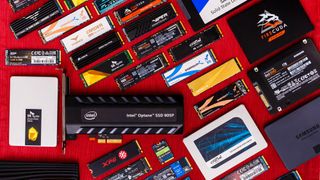
Amongst the key components in any PC, the storage drive is slowest: transferring $.25 in a fraction of the fourth dimension your CPU and GPU take to process it or your RAM takes to load it. A poor-performing storage drive often leads to a big bottleneck, forcing your processor (fifty-fifty if it's 1 of the best CPUs for Gaming) to waste clock cycles, waiting for information to crunch.
Finding the best SSD or solid-state drive for your specific arrangement and needs is key if you want the best gaming PC or laptop, or fifty-fifty if yous just want a snappy productivity machine. To discover the best SSDs for gaming and productivity, we examination dozens of drives each year and highlight the all-time ones here. Nosotros've as well added in a best SSD for NAS category.
Picking the Best SSD for You
The latest NVMe SSDs have undercut mainstream drives on the slower SATA interface (which was originally designed for hard drives), but we shouldn't expect to see the cease of SATA drives in the near future. Companies are still doing new things with SATA, like Squad Group's cavernous 15.3 TB drive. Existing SATA drives will take to continue to get more than affordable in guild to at to the lowest degree compete on price, merely they can't hope to go on upward with newer NVMe drives on performance.
Blazing-fast PCIe iv.0 M.2 SSDs, which offer up to double the sequential speeds of the older PCIe three.0 standard, have become mutual with Intel and AMD's electric current platforms both supporting them. In a desktop, you'll need either an X570 motherboard or B550 board on the AMD side, or a Z690 motherboard from Intel.
If your desktop system can handle a PCIe 4.0 drive and you lot tin can pay a piffling actress for it, they're the best SSDs for gaming. For example, the SK hynix P41, our current pick for all-time SSD overall, is rated for 7,000 MBps reads, six,500 MBps writes and 1.4 / 1.3 million IOPS. That ways less fourth dimension waiting for game levels to load or videos to transcode. For about laptops, PCIe 3.0 drives are the best SSD choice, because they use less power.
Believe it or not, raw speed isn't everything. In regular productivity tasks such equally web browsing or lite desktop piece of work, you may non even detect the difference between a PCIe 3.0 SSD and one with a 4.0 interface.
Ultimately, the all-time SSD for y'all is one which provides enough capacity to hold your data at a price you can afford. Consider that a high-end, AAA game can utilise more than 100GB of data and Windows 11 all by itself may need 60GB.
When choosing an SSD, consider the following:
- Pick a compatible interface (M.2 PCIe, SATA, Add-in Card): Await at your user manual or a database similar the Crucial Retentivity Finder to decide what types of SSD your computer supports.
- 500GB to 2TB: 1TB is the practical minimum any PC build (perchance one of the best PC builds) that costs more than $500. 2TB is the best SSD size for anyone that tin can spend $200+ on a drive. 500GB is the bare minimum anyone should consider at any toll. 4TB drives are an expensive luxury at this bespeak.
- SATA is slowest: SATA isn't as fast as M.ii PCIe or a PCIe add-in card, just the bulk of desktops and many laptops can take 2.5-inch SATA drives and many doing typical mainstream tasks users won't notice the divergence between a good recent SATA bulldoze and a faster PCIe model anyway.
For even more information, check out our SSD Buyer's Guide. Or if you're looking for an external SSD, you tin can check out our Best External Difficult Drives and SSD page, or learn how to save some money by edifice your own external SSD. Below, you'll notice our recommendations for drives with all three major interfaces.
Best SSDs Y'all Can Buy Today
Tiptop SSDs Overall
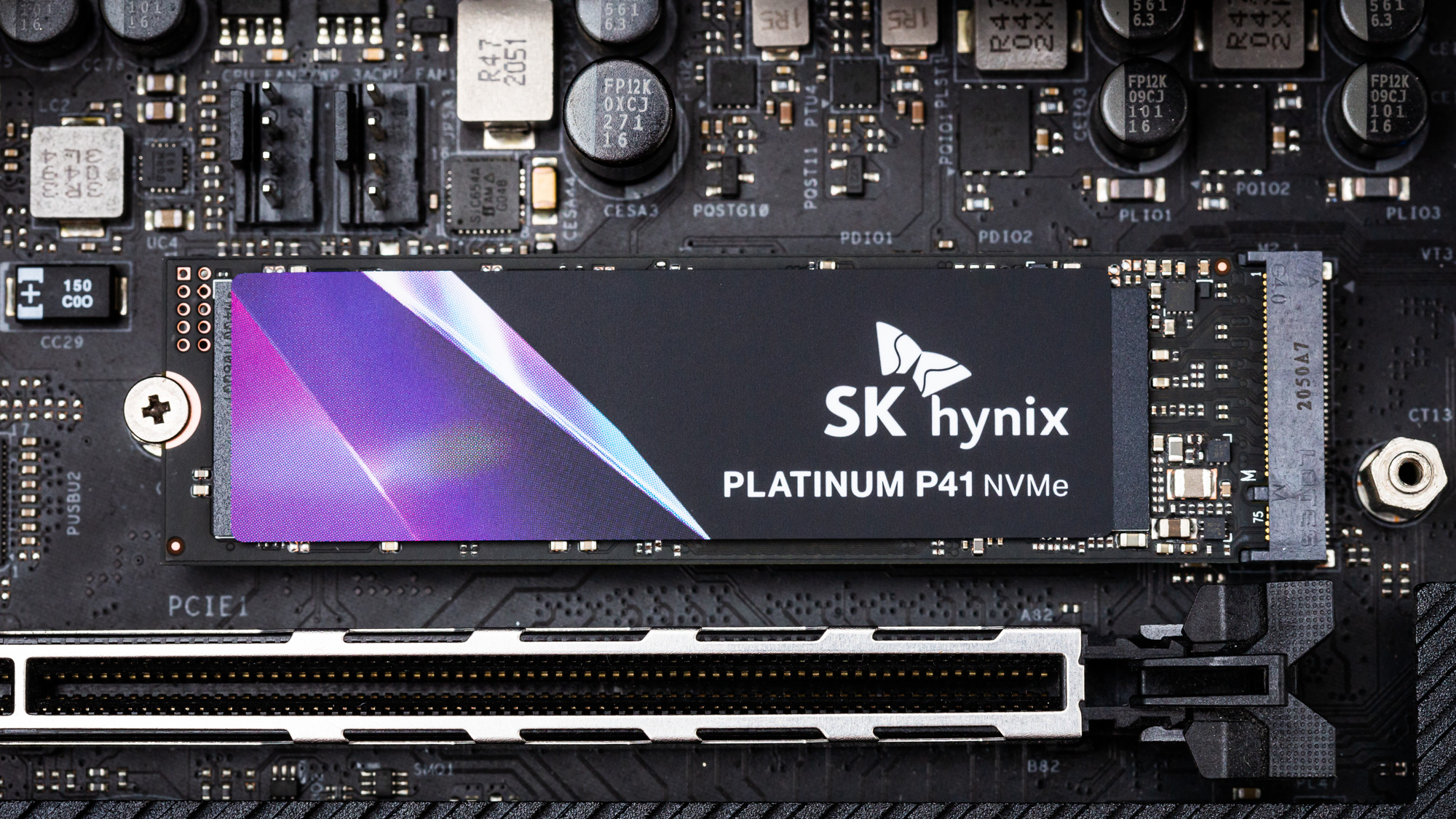
SK hynix managed to one-upwards themselves by improving on the already-great Gold P31. The Platinum P41 takes the bones elements that fabricated the Gold P31 so great and turns the dial to 11. The Platinum P41's performance is excellent with few if any pitfalls, providing excellent balance for a PCIe 4.0 consumer SSD. SK hynix also provides a SSD toolbox and Macrium-based imaging software to circular out the package, all with a reasonable warranty.
The Platinum P41 does run a fleck hot under sustained load and SK hynix doesn't provide a heatsink in the box. We recommended ownership one. It tin besides be difficult to find SK hynix'southward drives in some regions, at least at a reasonable cost. Withal, availability in the U.S. already seems sufficient with competitive pricing. If you want the best all-effectually drive, this is the one to get.
Read: SK hynix Platinum P41 Review
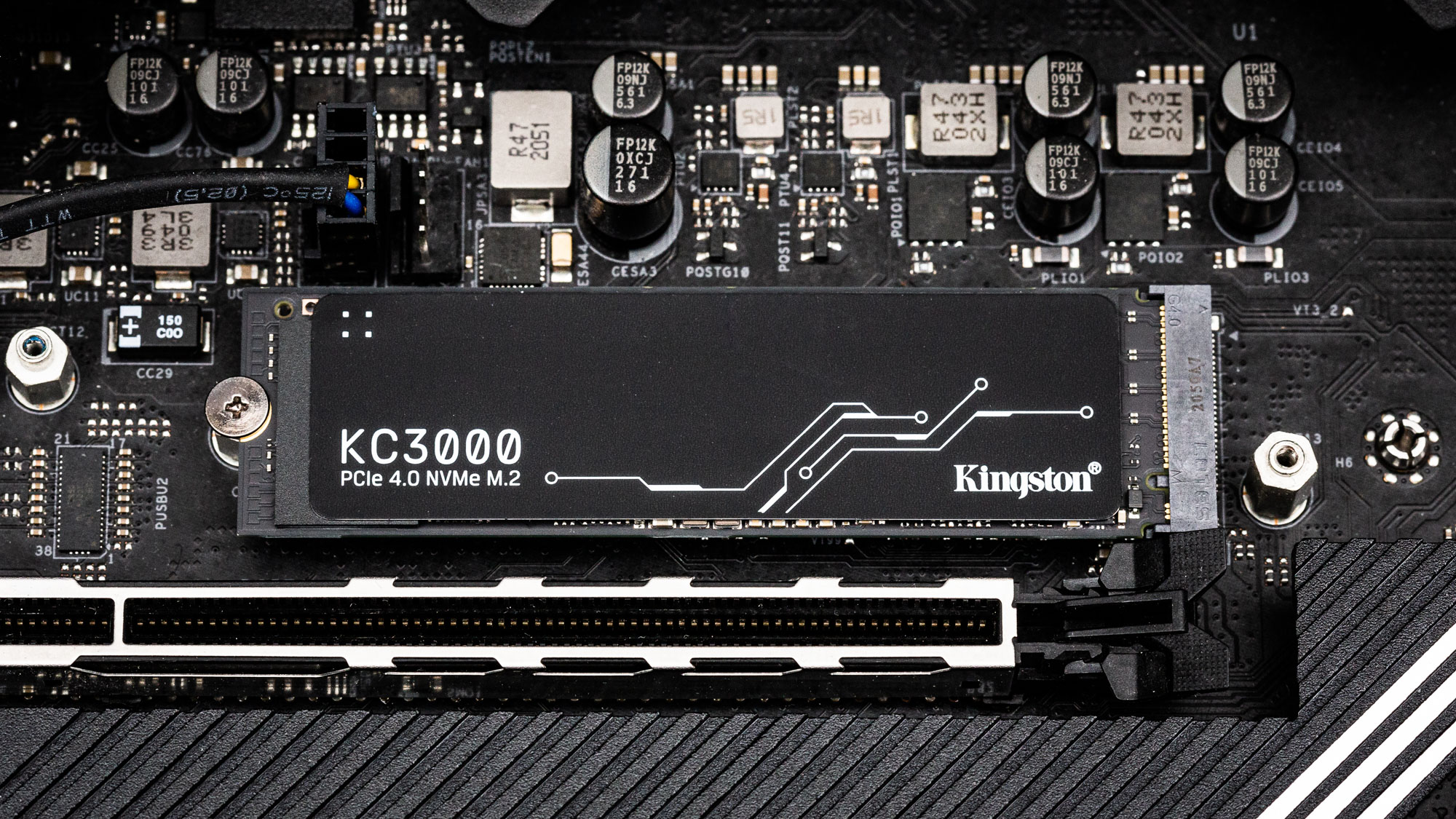
If you're looking for the fastest SSD on the market place, Kingston's KC3000 fills that part, specially now that Intel has stopped producing its Optane products. The KC3000 is a high-performance PCIe iv.0 x4 NVMe SSD that radishes out haemorrhage-edge speeds of upwardly to 7 GBps of read and write throughput, forth with up to one meg IOPS.
Similar to the Seagate FireCuda 530 and Corsair MP600 Pro XT, the Kingston KC3000 is powered by the Phison PS5018-E18 and comes paired with Micron's 176-Layer TLC flash. Nonetheless, the KC3000's flash is faster at ane,600 MTps than the MP600'south 1,200 MTps, giving information technology a tactical advantage.
The 2TB Kingston KC3000's endurance and performance comes out on pinnacle of the Samsung 980 Pro, merely that comes at the toll of efficiency. That translates to shorter battery life for laptop applications. The KC3000 also doesn't come with OPAL-compliant AES hardware encryption and comes in a double-sided course cistron at higher capacities. That ways the KC3000 may not be the best option for your mobile device, but is a fantastic SSD for those edifice a loftier-end desktop for gaming or workstation for productivity.
Read: Kingston KC3000 Review
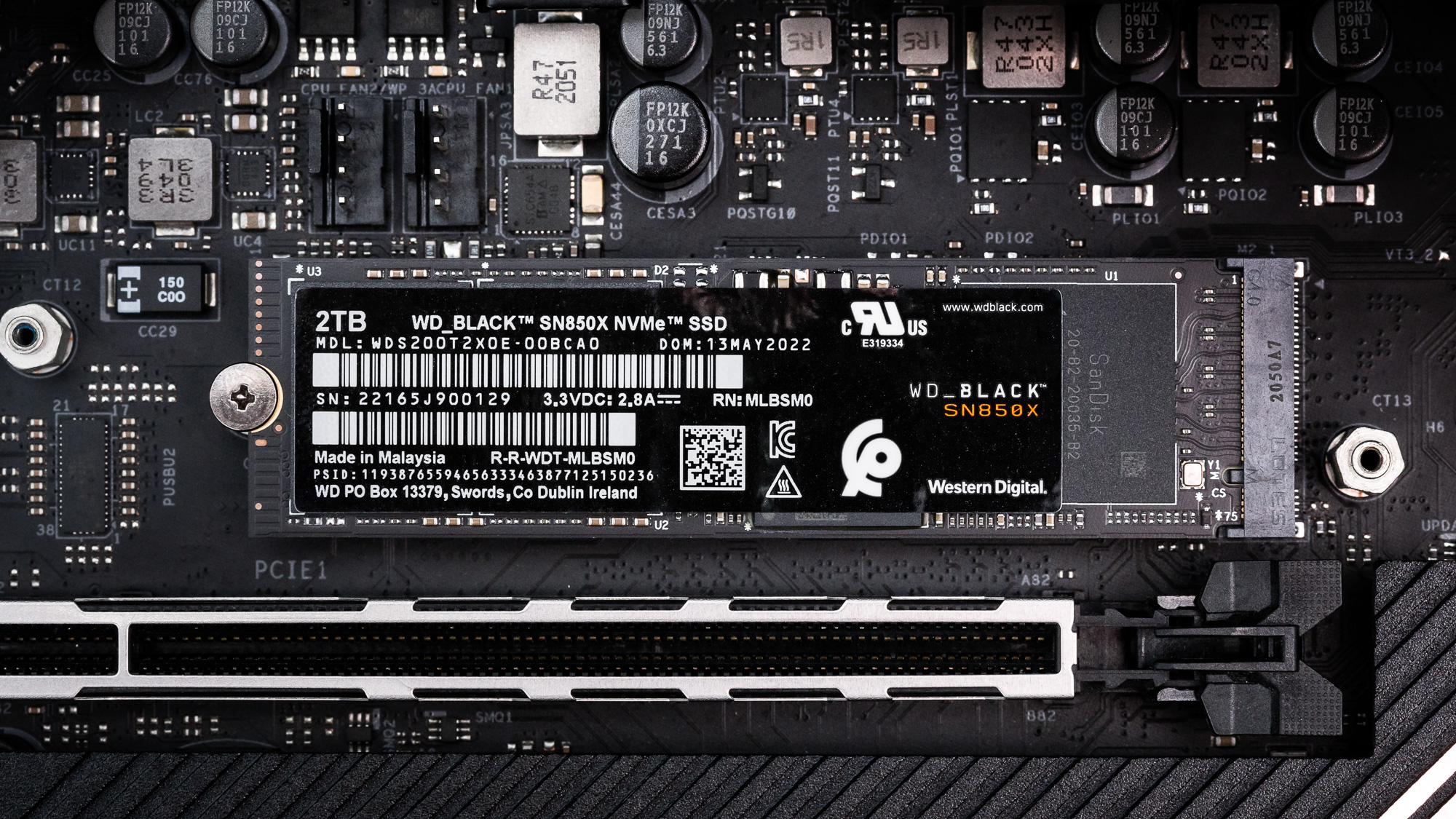
WD has taken its popular Black SN850 SSD and turned information technology up to 11. The Black SN850X leverages an improved controller and newer flash to go the most out of PCIe four.0. Operation is improved across the lath and the drive comes shut to rivaling the Platinum P41 in about ways. Unlike the Platinum P41, it offers a heatsink pick that also comes with RGB at 1TB and 2TB. WD too supports the SSD with its decent Dashboard application and a respectable warranty.
The Black SN850X was a bit pricey at launch, however, with a daunting MSRP. The touted Game Fashion ii.0 characteristic felt incomplete in our testing, although WD ensures united states that this will amend with future firmware updates. We do like the idea of a drive that's made for the PlayStation 5, and also one that's super fast for gaming on a PC, particularly with DirectStorage on the horizon. All-in-all, this is a good compromise if yous tin can't notice the Platinum P41.
Read: WD Blackness SN850X Review

The Crucial P3 is the little sibling to the P3 Plus. There's not much departure betwixt the 2, other than the P3 being limited by its PCIe 3.0 interface. This isn't all bad, equally the P3 is a bit cheaper and as well more efficient. In fact, it'due south incredibly efficient, making it a useful improver to any system. The lack of a 4.0 interface reduces its maximum bandwidth and sequential performance, plus puts it out of range for employ in the PlayStation v.
It's nice to come across some newer hardware in the PCIe iii.0 SSD market segment, especially with capacities upwardly to 4TB. Crucial backs it with a total 5-yr warranty and decent software support. However, its guaranteed write endurance is quite low. The P3 is based on QLC and is as well DRAM-less, and then it might be prone to potential functioning issues. It's also best at higher capacities. Still, it'due south a proficient option on sale for an upgrade, or if yous just need more NVMe-course bulk storage.
Read: Crucial P3 Review
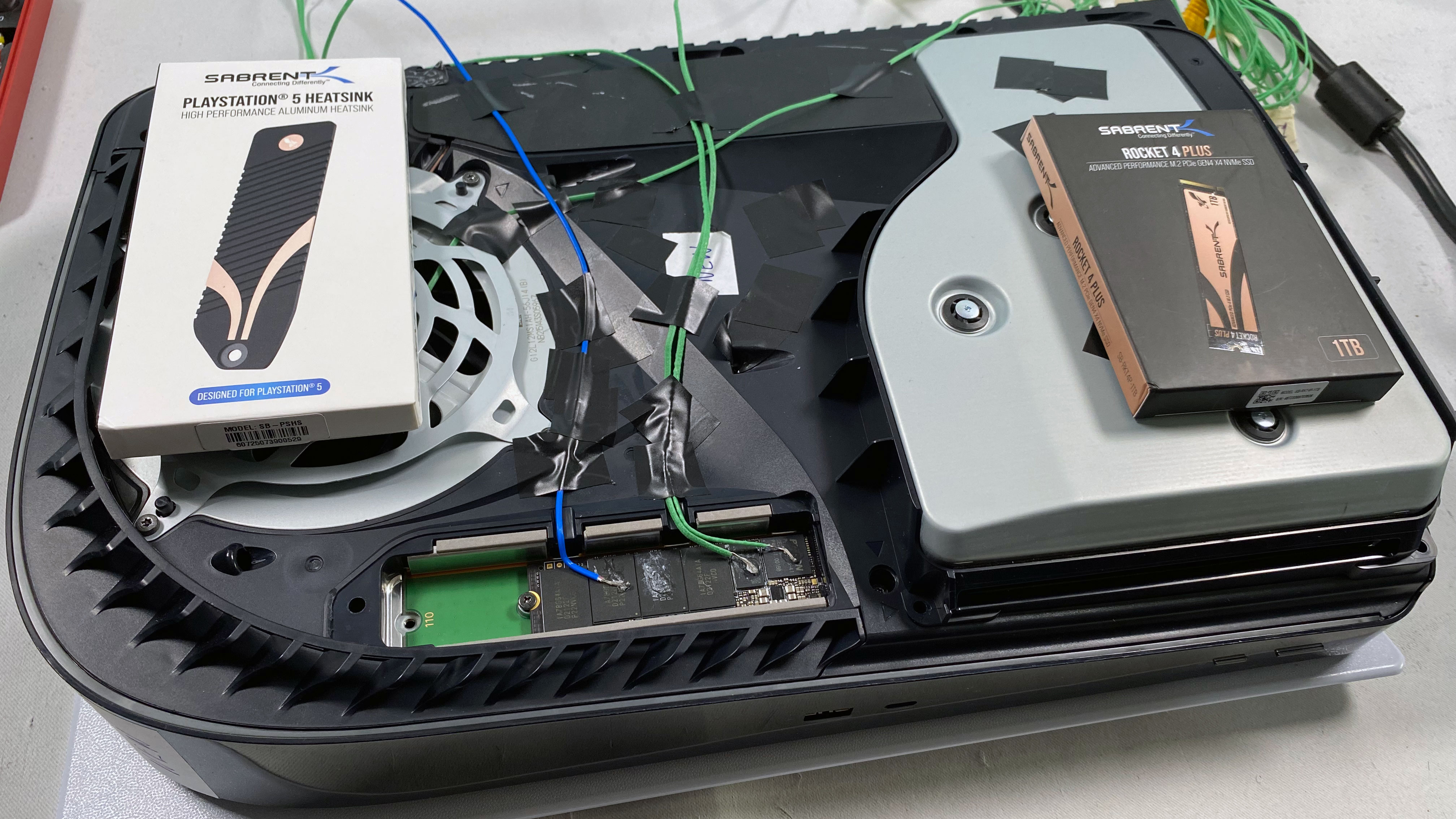
Sabrent takes its flagship PCIe 4.0 bulldoze and makes it improve with a bundle that includes thermal record and a PS5 heatsink. This heatsink is designed specifically to fit the PS5 and makes utilise of its natural airflow. Thermal tape is included for tight bonding, ensuring better thermal dissipation. This combination ways you can take a fast PS5 drive without worrying almost the drive overheating.
While the heatsink is available separately and will work on other drives, the bundle makes it easy to get the very best performance out of the box. The Sabrent Rocket 4 Plus now comes with fifty-fifty better 176-layer TLC flash, boosting its pinnacle functioning. Information technology is also available up to the PS5'due south current capacity limit of 4TB for an expansion bulldoze. The primary caveat is that in that location are significantly cheaper options that will get the job done with the PS5, similar the Silicon Power XS70.
Read: Sabrent Rocket iv Plus Review
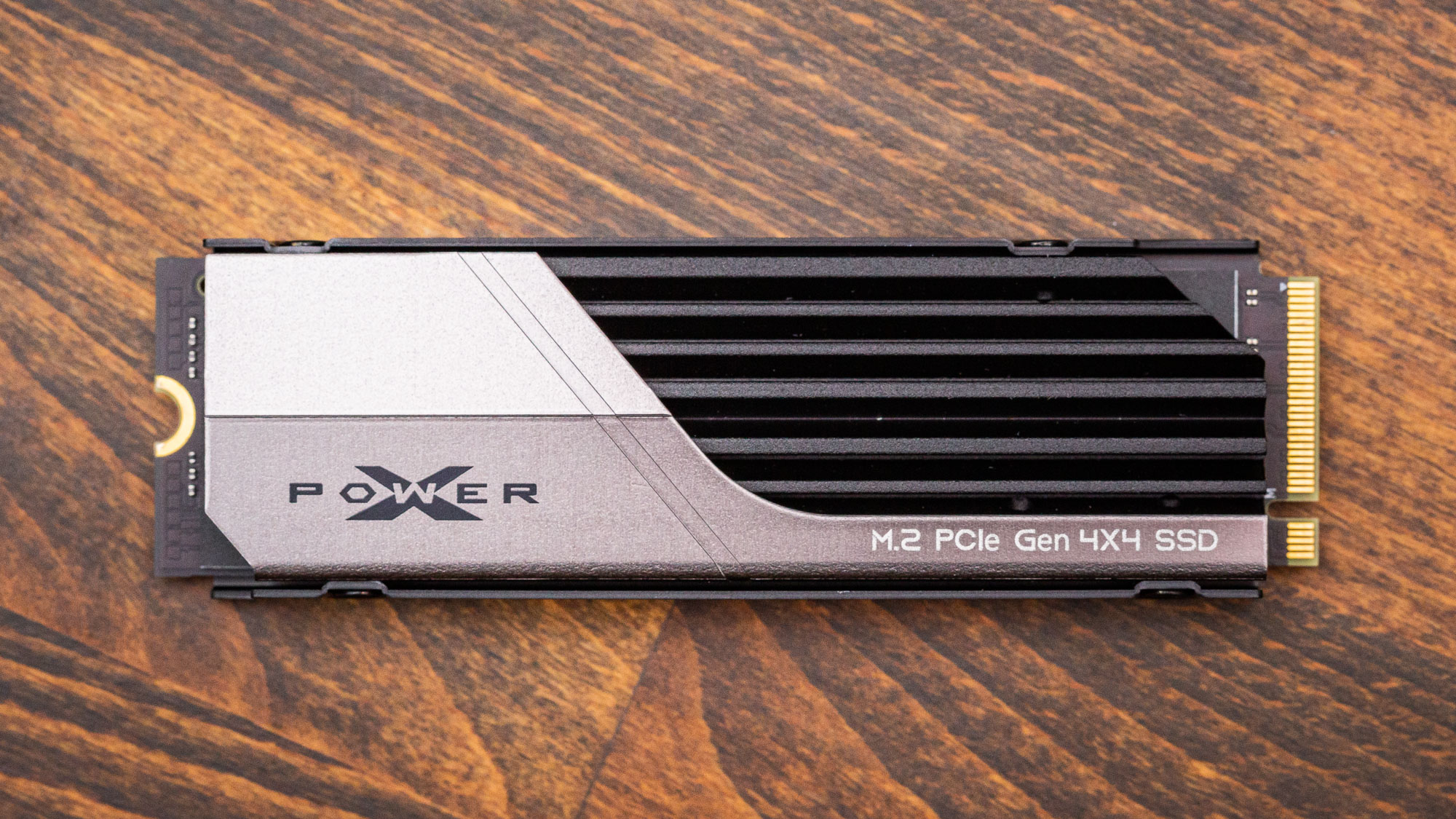
We like the Silicon Ability XS70 because information technology hits all the right notes: bully performance, an bonny heatsink, and solid pricing. This SSD has an fantabulous controller for PS5 usage and the newest flash, all with a heatsink designed to fit the PS5. Pricing at 1TB and 2TB is more than than reasonable and is better than the contest, all considered, although cheaper but slower options still exist.
We consider drives using the Phison E16 controller to be a significant budget option for PS5 use, but problems with speed have been reported. The strongest alternative would exist the S70 Blade. That bulldoze is too a skilful fit hither, but we find the XS70 more compelling on the whole.
Read: Silicon Power XPower XS70 SSD Review
Thousand.ii PCIe NVMe Drives
These pocket-sized, rectangular drives expect like sticks of RAM, just smaller. They are normally 80mm long by 22mm wide, described equally size 2280, merely some may be shorter or longer, then make sure you go one that matches your slot. You can get M.2 drives that back up SATA, but almost modern desktops and laptops with M.2 slots back up the faster PCIe NVMe standard.
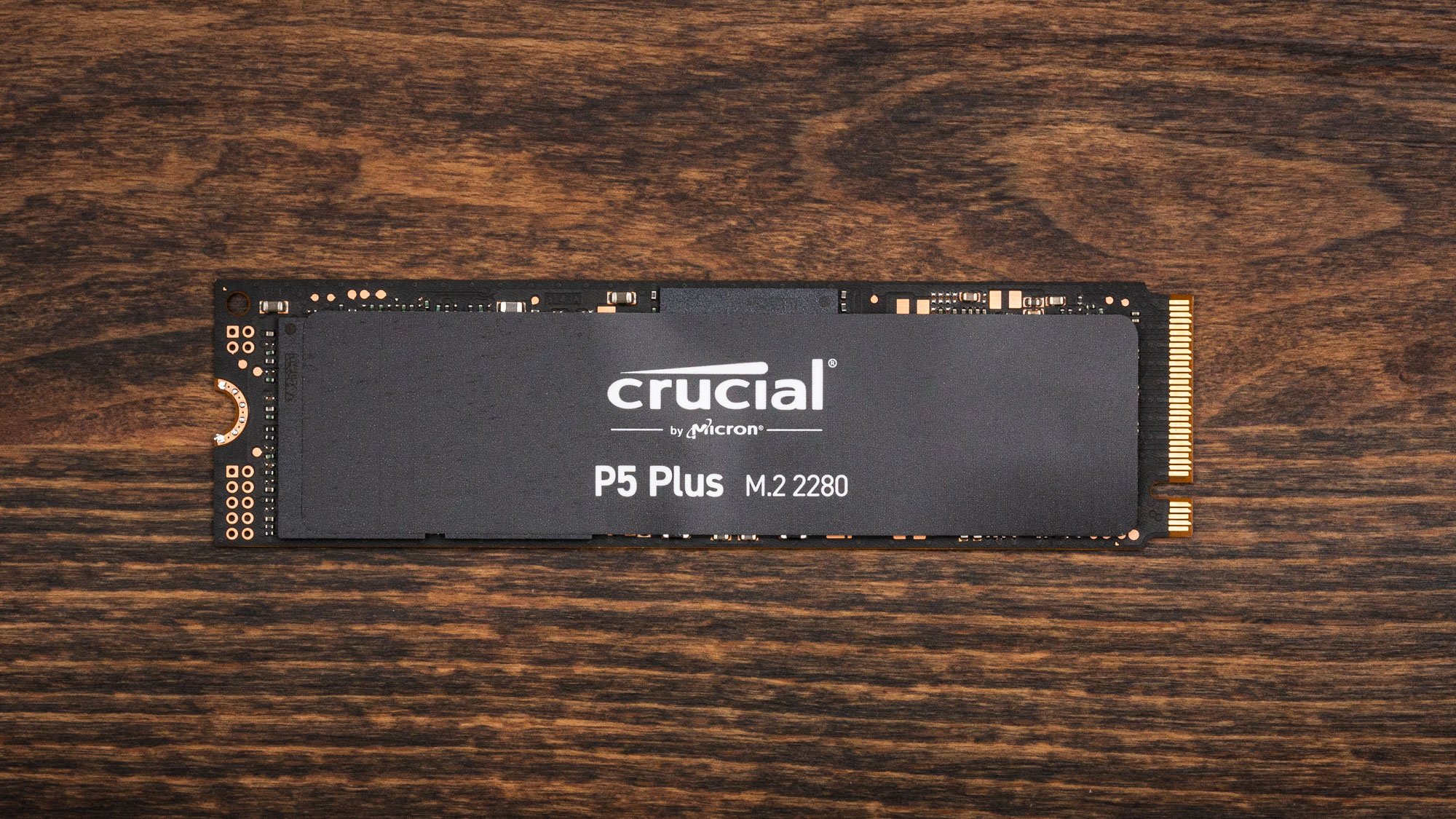
Crucial's P5 Plus is an evolution of the P5 with a focus on improved performance, especially where the original P5 let us down. Built for gamers and artistic professionals who want faster load times and more efficient workflows, Crucial's P5 Plus is a solid PCIe 4.0 x4 SSD that is priced well for its feature set.
Although it banks on value more than flat-out operation, the P5 Plus proved capable of keeping up with the best in most applications. Information technology features a host of specialized algorithms for information protection and hardware-based, OPAL 2.0-compliant AES 256-bit encryption for data security. If you can't quite afford the Samsung 980 Pro or WD_Black SN850, the P5 Plus is a solid performing alternative that'south worthy of your consideration.
Read: Crucial P5 Plus Review

Powered by Phison PS5018-E18 PCIe four.0 x4 NVMe SSD controller and Micron's 96L TLC wink, the Sabrent Rocket four Plus boasts some serious hardware that enabled it to shatters write speed records in our testing. Not only is information technology fast, with its black PCB and matching blackness PCB and copper tone heat spreader, merely it'south as well a very attractive One thousand.ii. At prices that undercut both WD and Samsung, information technology's a bang-up value for those looking to save some cash, but still, get that responsive PCIe 4.0 performance. Plus, information technology comes in a spacious 4TB capacity, different the WD and Samsung, too. Merely, behave in mind that at its lower price indicate information technology lacks AES 256-bit hardware encryption and comes with a 1-year warranty without registration within 90 days.
Read: Sabrent Rocket 4 Plus Review
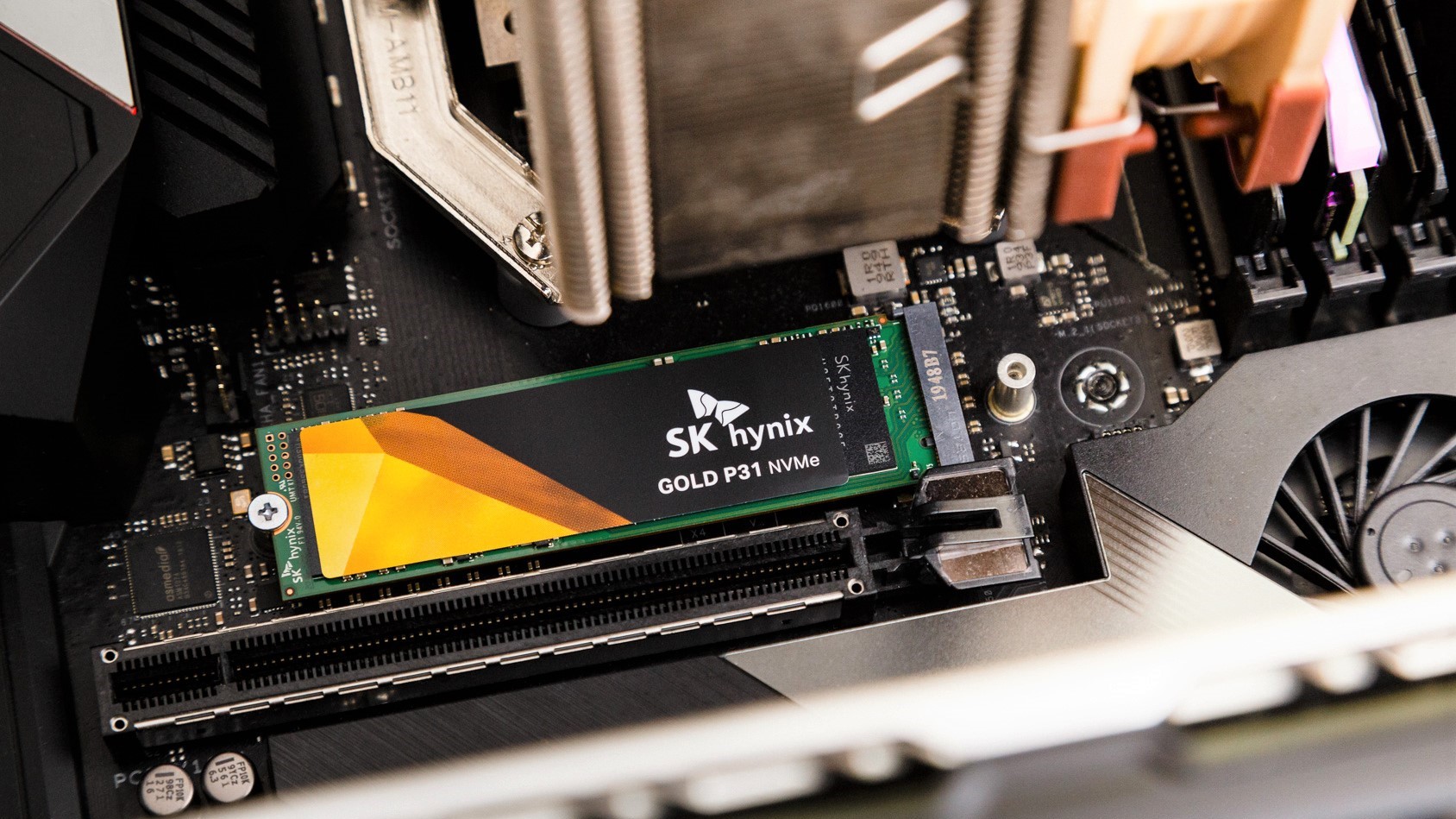
SK hynix's Gold P31 touts market leadership as the showtime retail SSD product to launch with 128-Layer flash. With SK hynix'due south newest wink reaching incredible chip density, the Gold P31 hits the marketplace at very low pricing. Listed at competitive prices, the Gold P31 is a fantastic value that volition make y'all think twice nigh spending that extra $25-$50 on the Samsung 970 EVO Plus.
SK hynix's Gold P31 is great if y'all're looking to increase your laptop storage, not only to gain capacity only to gain battery life, too. While some drives may perform well against the Gold P31 in benchmarking, the SK hynix is much more power-efficient, which will lead to longer off-the-charger sessions. Laptop users who prioritize battery life should definitely put the new SK hynix Gold P31 at the height of their drive listing. Additionally, the Gold P31'due south very strong write performance and ultra-loftier efficiency go far a well-rounded selection for many desktop users as well.
Read: SK hynix Gold P31 Review

We're quite impressed with the Samsung 970 EVO Plus. Like the WD Black SN750, Samsung's drive carries over the same controller as its predecessor. But instead of refreshing it with the same flash, Samsung decided to switch things up a bit with its new 9x-layer flash. Only every bit the wink is stacked to new heights, performance hits new highs, too. The resulting drive is exactly what its name says: a big Plus.
As the first widely-available retail SSD to hitting the marketplace with Samsung'due south latest 9x-layer flash, the Samsung 970 EVO Plus delivers the same operation as the 970 EVO, plus more than. The drive consistently proved that it has some of the strongest write functioning on the market and can handle tough workloads. Information technology fifty-fifty trounce out Samsung'southward own 970 PRO in a few tests, which is quite the feat considering the PRO slots in as Samsung's workhorse for workstation-class applications.
Read: Samsung 970 EVO Plus Review

Crucial's P5 is a mainstream PCIe 3.0 x4 M.2 NVMe SSD that has a lot of applied science put into its design with Micron'south in-house designed six-core NVMe controller and some of the latest 96L TLC flash available, but ultimately, the visitor banks on its value to entice its purchase. While information technology isn't as bleeding edge fast as the newest Gen4 SSDs on the market and it can become quite hot under heavy loads, the P5 still holds its own for what it is.
Crucial's P5 is capable of delivering sequential read and write speeds of up to three.4/iii GBps, looks great with its blacked-out aesthetic, and comes in a slim, single-sided M.2 form factor for broad compatibility. It also comes supported with a standard 5-year warranty and boilerplate endurance ratings, along with some value adder software as a bonus. It fifty-fifty features hardware-accelerated AES 256-flake encryption that is OPAL complaint. But, all-time of all, in recent times information technology's gotten even more affordable than ever. Gamer, prosumer, or just your average PC user looking for a storage upgrade, the Crucial P5 is priced to sell at a very lost cost, making information technology a solid value for those trying to save a few bucks over the absolute best SSDs.
Read: Crucial P5 Review
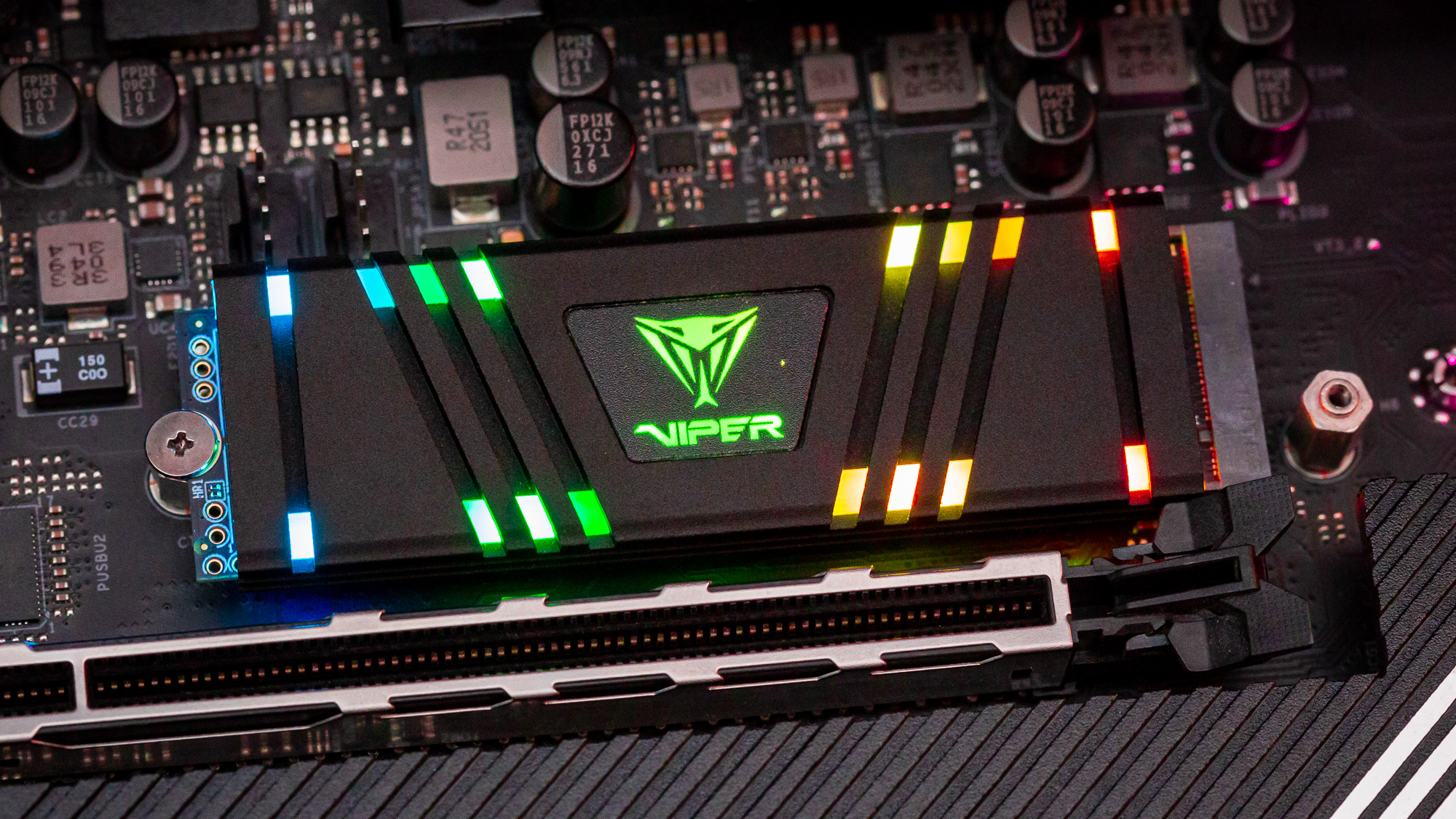
Patriot'south Viper VPR400 could be seen as the successor to their now-retired VPR100. The heatsink is essentially the aforementioned, every bit is the RGB. Patriot's sync software works with ASRock, ASUS, Gigabyte, and MSI. In practice, enabling this style does depict more power and produce more than oestrus merely neither should be a problem in a well-ventilated desktop case. Patriot backs all of this upwards with a 5-twelvemonth, 800TBW-per-TB warranty.
Functioning is good, as would be expected from a bulldoze with InnoGrit'due south IG5220 controller and Micron's 176-layer TLC flash. While DRAM-less and not equally fast as loftier-end PCIe iv.0 drives, this combination remains competitive and more than plenty for nigh users. However, the aesthetics come at a price: the Viper VPR400 is very expensive for what it is. This is therefore a bulldoze for the gamer who is willing to pay more for the perfect thematic build.
Read: Patriot Viper VPR400 Review
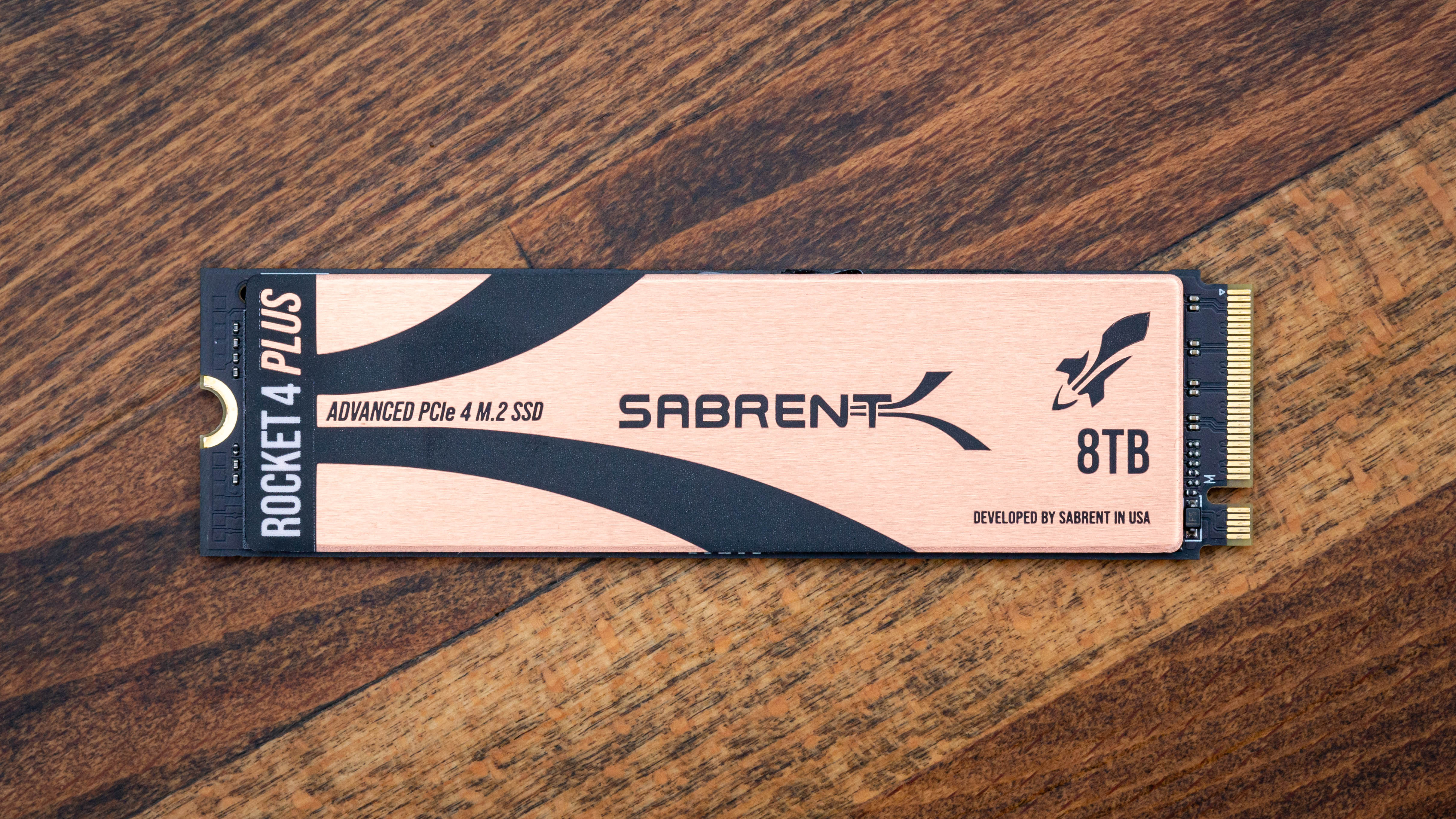
Sabrent is no newcomer to high-capacity SSDs. The company beginning hit 8TB with their Rocket Q, but now it has a TLC drive at that chapters. Currently, no other manufacturer offers a consumer 8TB TLC drive. Every bit such, this drive offers the all-time of both the capacity and performance worlds, simply it comes at a steep toll.
The Rocket four Plus has a powerful controller and newer flash, simply there are some downsides from pushing the capacity envelope: information technology has lower power efficiency and weaker all-around operation than some of its lower-capacity peers. That means other drives with this controller and Micron's 176-layer flash do perform better, but they don't offering nigh the same capacity. Overall, the 8TB Rocket four Plus is the fastest 8TB SSD nosotros've always tested, offering the highest performance available at this capacity point. If you're looking for a better value, though, turn to the QLC version of this same drive.
Read: Sabrent Rocket 4 Plus SSD Review
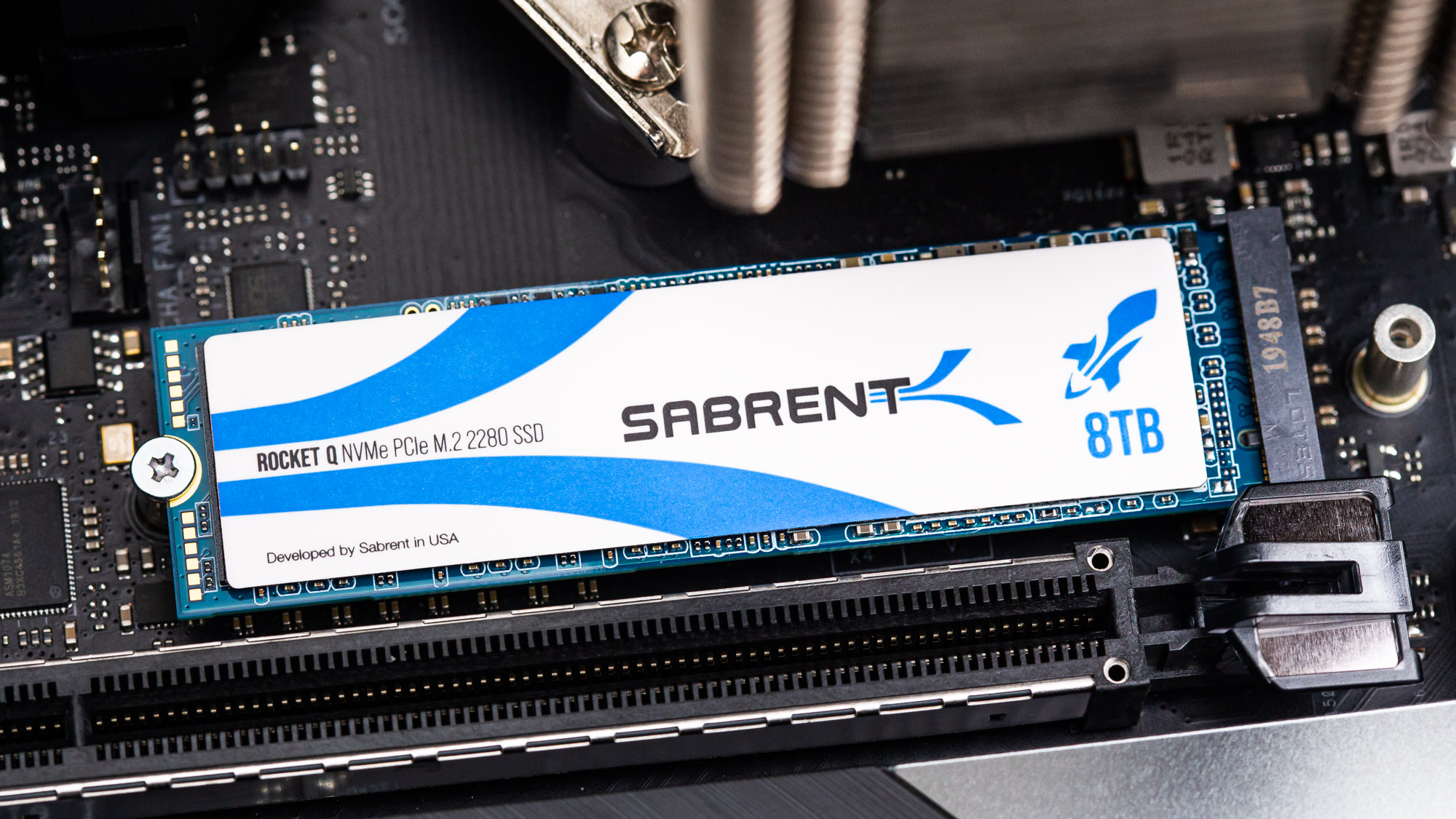
Sabrent's 8TB Rocket Q slots in as the industry'south highest-capacity M.2 NVMe SSD. The pint-sized monster is apparently best suited for the data hoarder on the go, simply at $ane,500, it'll prepare you back most equally much as some of the best gaming laptops. The drive doesn't just push button chapters to the highest we've seen with a slim 1000.two SSD; it too impresses with great performance and efficiency, thanks to the new Phison E12S controller and 96-Layer QLC flash. That said, you can expect to the Rocket iv Plus (listed in a higher place) if you're after the fastest 8TB SSD on the market place.
QLC flash does have its downfalls, similar lower endurance and slower write performance after the SLC write cache gets filled upwards during large file transfers, merely the Phison E12S controller helps push the Rocket Q to evangelize respectable performance. The pricing is far more amenable than faster alternatives at this capacity, too.
Read: Sabrent Rocket Q Review
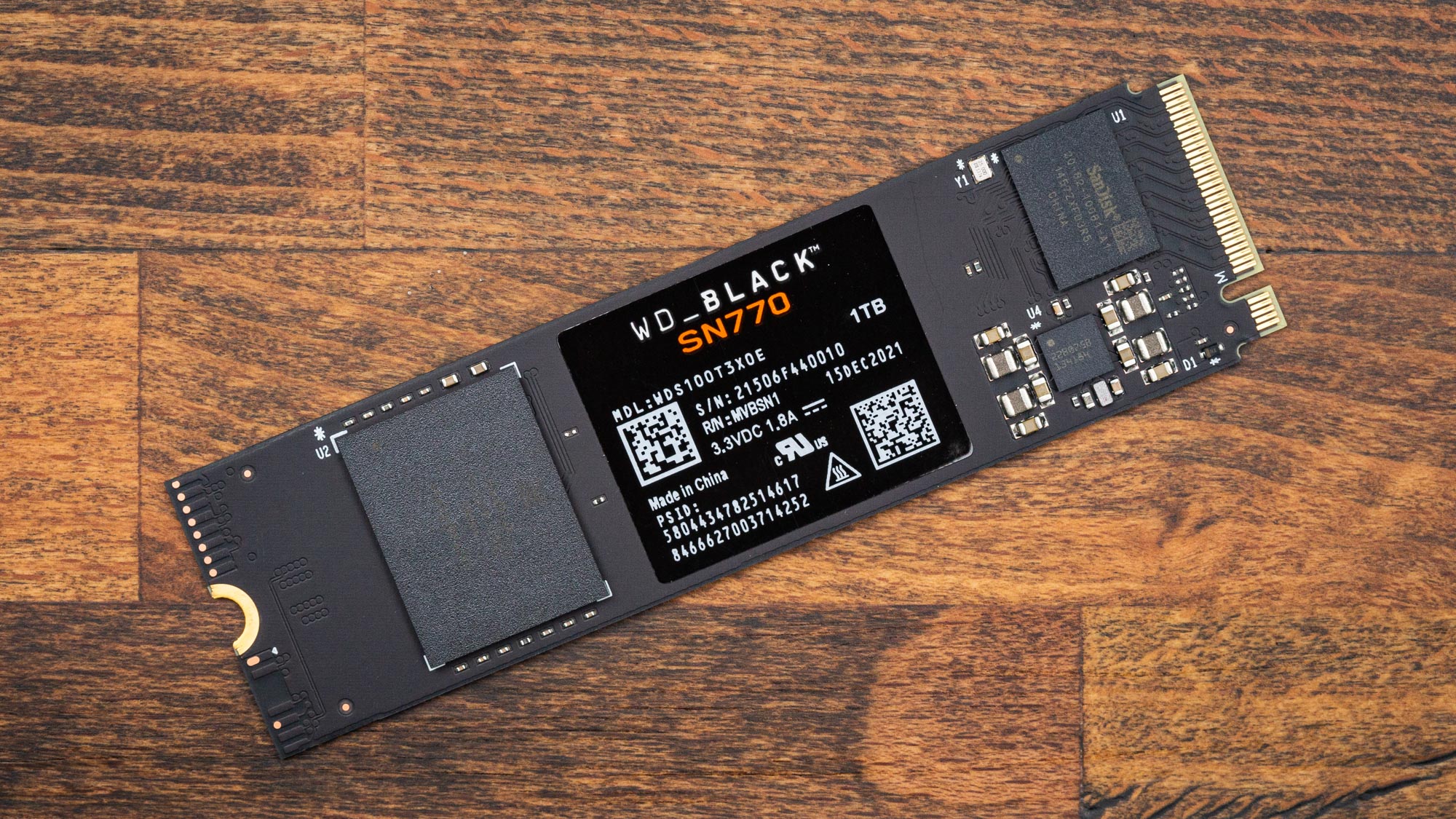
Powered by WD'south in-house four-channel DRAM-less architecture and packing the latest BiCS5 TLC flash, WD'southward Blackness SN770 breaks the mainstream mold. Although its peak bandwidth is a bit limited due to its iv-channel controller, the SN770 withal trades blows with the best, dishing out sequential speeds of upwardly to 5.fifteen/4.nine GBps read/write and up to 740,000/800,000 random read/write IOPS.
Not only is the SN770's peak operation exceptional, only its QD1 operation is also exceptional, meaning the drive is enough snappy. With Game Fashion enabled via WD's SSD Dashboard, the Black SN770 can dish out random read speeds that rival the more plush Black SN850. Information technology is also backed with the same endurance ratings and a v-year warranty.
Overall, the WD Black SN770 delivers exceptionally fast performance and is a solid selection for both gamers and mainstream users looking for a consistent-performing SSD at a reasonable price.
Read: WD Black SN770 Review

Silicon Ability'south UD90 enters an increasingly-crowded mid-range PCIe iv.0 SSD market place segment, but this bulldoze manages to stand up out anyway due to its low price. The 1TB SKU, bachelor on Amazon, undercuts other drives within its operation range. This makes it suitable as a budget PlayStation 5 or PC bulldoze, but capacity options are express. Information technology can also run a flake hot when pushed to its limits, although this should rarely be an issue.
The UD90 demonstrated stiff performance marks beyond most benchmarks with some peaks and some valleys versus competing drives. This is the first drive based on Phison's E21T controller that we reviewed and we were pleasantly surprised: not only did it keep up with the competition in performance, it did so while beingness extremely power efficient. The warranty is likewise competitive, significant this drive is a strong pick if you want to salvage a few dollars without compromising on operation.
Read: Silicon Power UD90 Review

WD'south Blue SN570 is a solid choice for mainstream builders putting together a new system or even gamers on a upkeep. The Blue SN570 delivers snappy functioning in most consumer work thanks to its BiCS5 TLC flash and an improved NVMe SSD controller pattern. This pairing makes for a forty percent improvement in sequential functioning and solid gains in 4KB random read workloads, positioning it shoulder-to-shoulder against Samsung's 980. Even so, at lower prices than the Samsung 980 and also backed with a solid warranty, support software, and decent endurance ratings, the WD Blue SN570 is an even better value.
Read: WD Blue SN570 Review
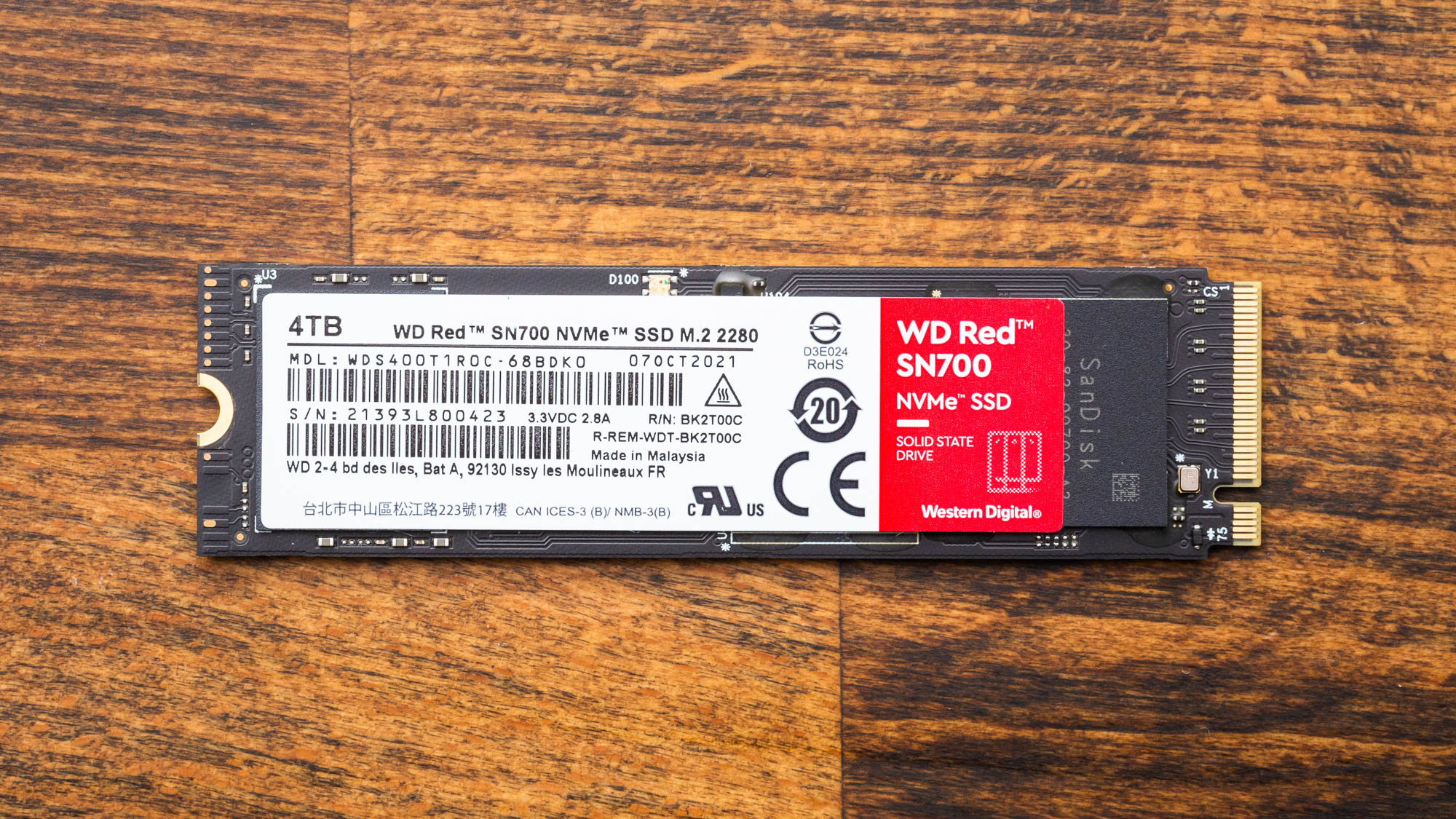
This drive is effectively an updated WD Black SN750, which was known for its consistent performance and good efficiency, merely it'south tailored for NAS usage. That combination makes it a overnice choice for a NVMe NAS SSD, especially when coupled with TLC upward to 4TB.
The WD Red SN700 doesn't offer anything special for the general user, but is dandy for employ in a NAS. The underlying technology is besides starting to evidence its age, merely that maturity is important for disquisitional storage systems like a NAS where performance isn't as much of a focus. The WD Red SN700 also doesn't have power loss protection, although that isn't surprising as this drive isn't for an enterprise application. Notwithstanding, the warranty and rated endurance are potent, which makes this a adept buy for the right usage, which in this case is in a NAS.
Read: WD Scarlet SN700 SSD Review
SATA Drives
You can become a SATA bulldoze in the M.2 form factor, but most SATA drives are ii.5-inch models, which allows them to drop into the same bays that hold laptop hard drives. SATA drives are the cheapest and all the same the most popular.
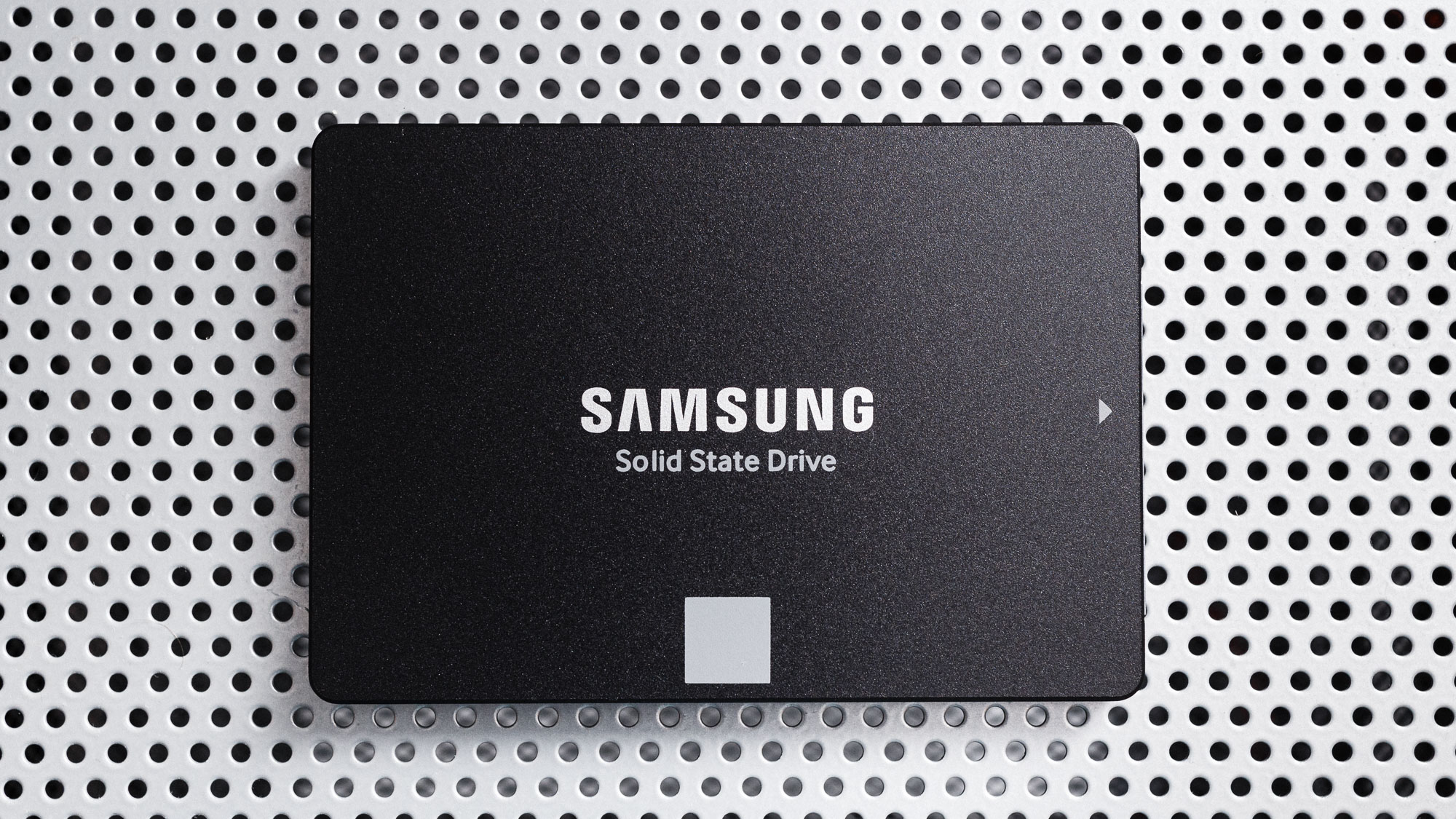
Samsung continues to show us that it has the all-time SATA SSDs on the market. Following in the footsteps of its predecessor with superlative-ranking performance, not bad power efficiency, and all the features y'all could want out of SATA SSD, the 870 EVO dominates. While not as endurant as the PRO models, the 870 EVO comes with enough endurance for most users. Whether you're a gamer or a prosumer, with high capacities of up to 4TB bachelor, there's a capacity for well-nigh whatever need. You don't demand to look further for a better SATA SSD – this is your best option.
Read: Samsung 870 EVO Review
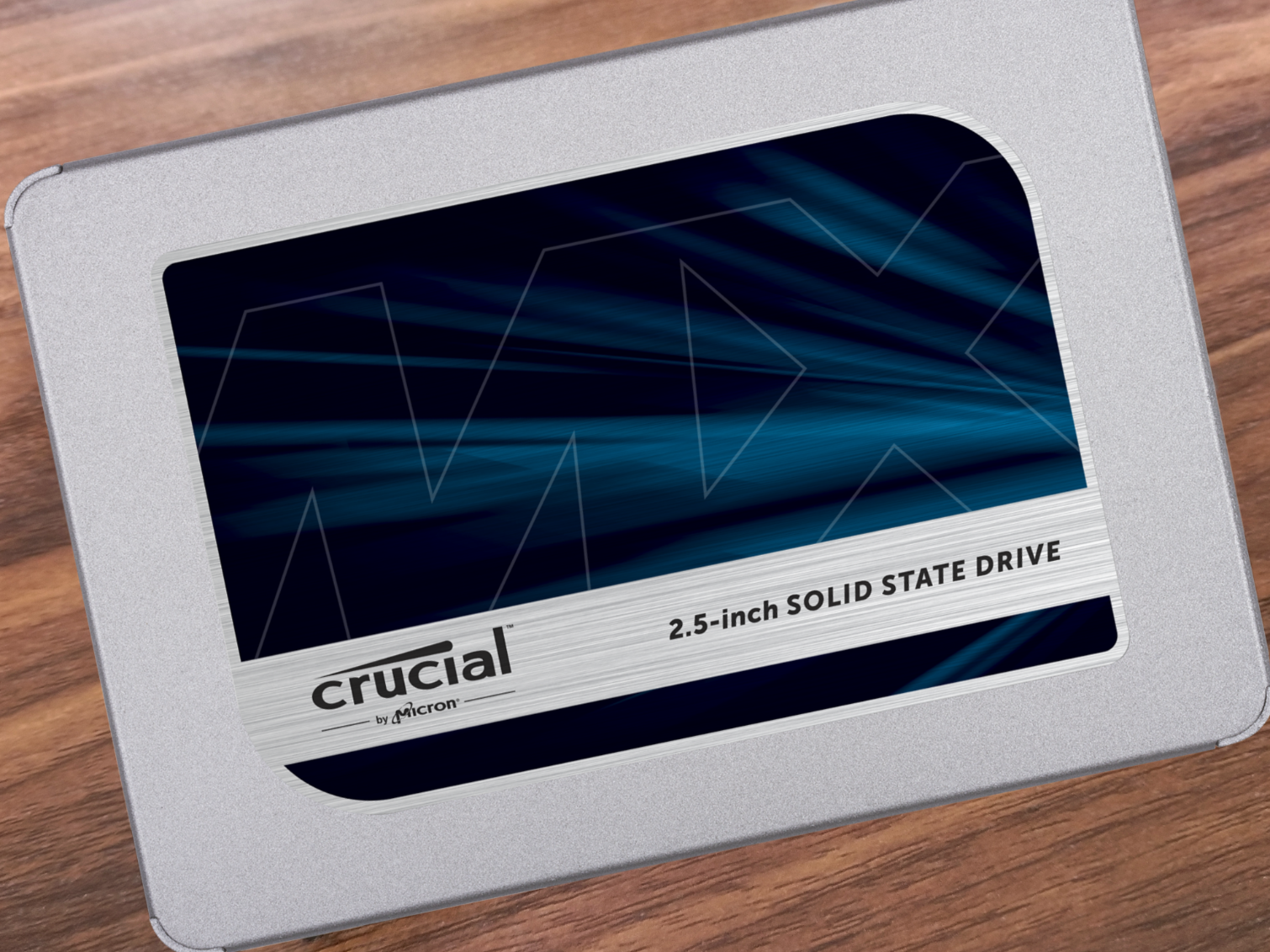
If you don't desire to dish out large bucks on something in the NVMe flavor but notwithstanding want strong SATA operation, the MX500 is a great choice. As an alternative to the Samsung 860 EVO, it offers similar performance and has a strong history of reliability. Normally priced to sell, the MX500 is a pinnacle value at any capacity you lot need.
Read: Crucial MX500 Review
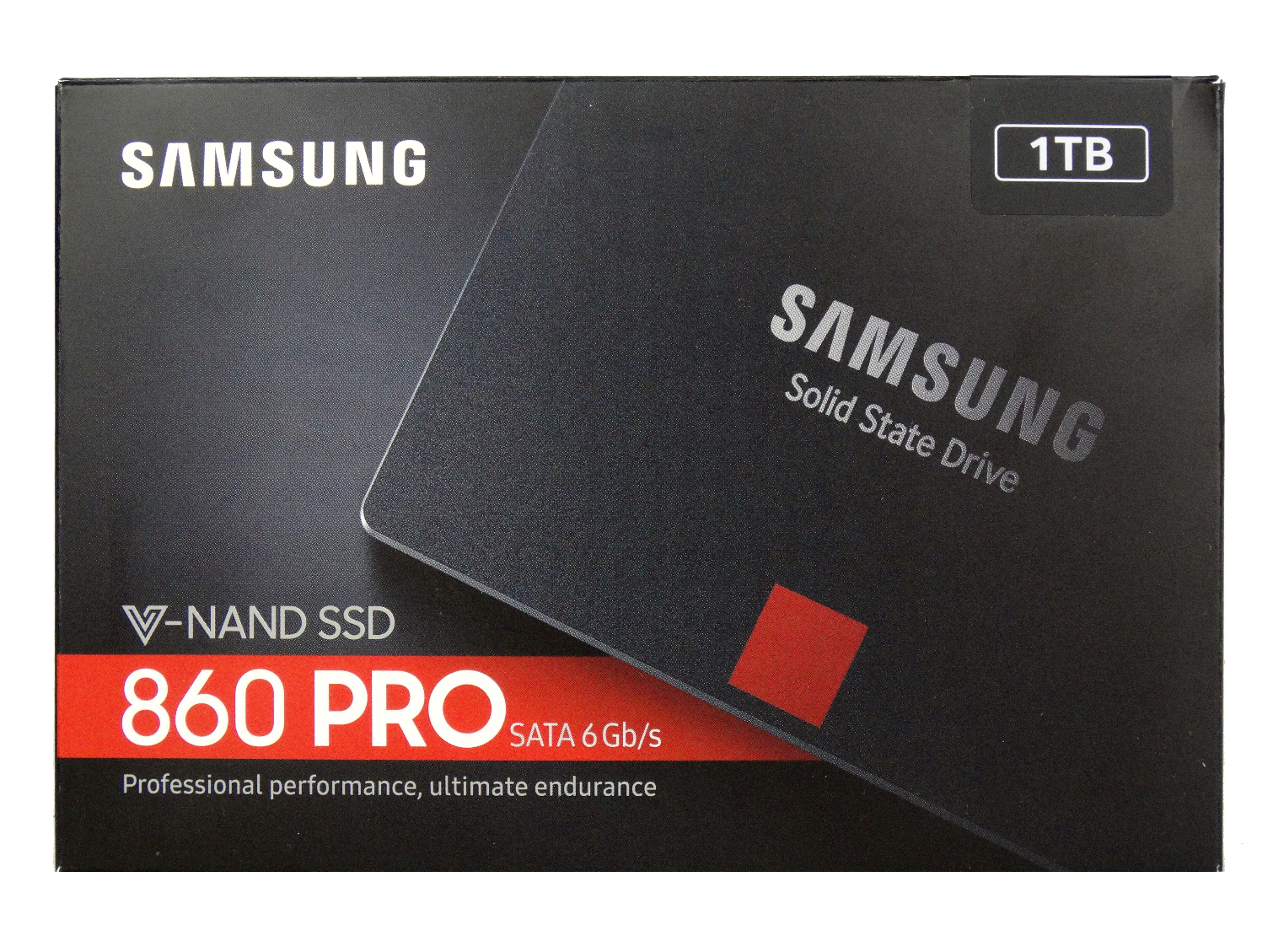
Restrained by the SATA interface, only however need the absolute highest endurance and performance you tin get? As the tiptop of SATA performance within and out, Samsung's 860 PRO is the SSD to purchase.
Like the Samsung 970 PRO, the 860 PRO uses Samsung'south 64L MLC 5-NAND, which helps propel it to the top of the charts in our rounds of benchmarking and makes for some incredible endurance figures. Yous can get capacities up to 4TB, and endurance figures can exist as loftier every bit 4,800 TBW. But with prices that are triple that of your typical mainstream SATA SSD, the 860 PRO is mainly for businesses with deep pockets.
Read: Samsung 860 Pro Review
Add-in Card SSDs
These drives are add-on cards, just similar graphics cards or sound cards, so they only work with desktops with a spare PCIe 3.0 x4, x8, or x16 slot. Nevertheless, because they are larger than other class factors, they accept room for more than fries and better cooling, making them the fastest drives around.
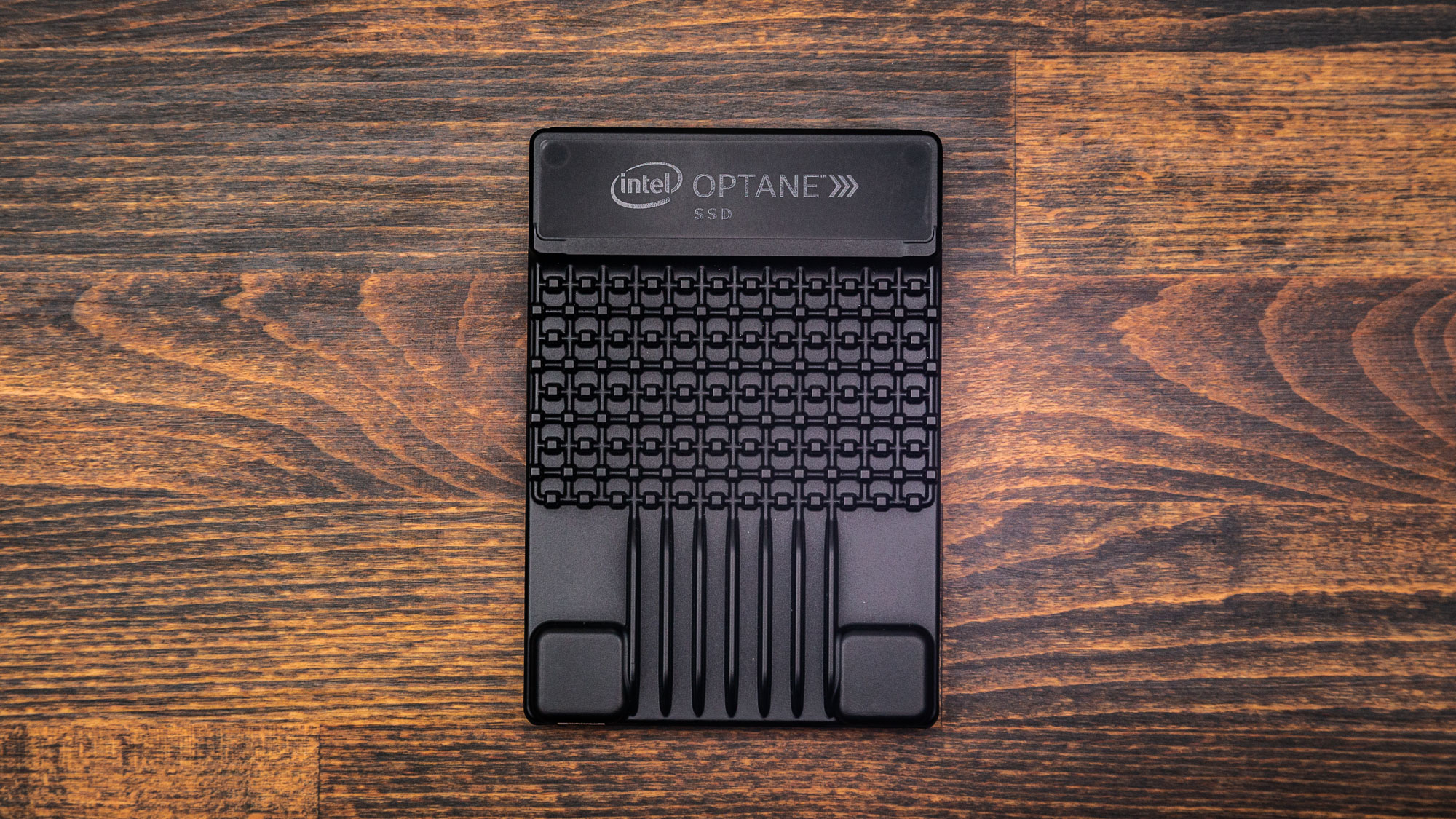
You could go by with using 1 of our top M.ii picks for workstation apply, but wink devices have rather limited capabilities in mixed workloads, then they tin can still clogging the well-nigh grueling workloads. For those who don't desire to just 'get by,' but absolutely remove storage as a potential clogging, so Intel's Optane SSD DC P5800X is for yous. This is a U.2 design, so you lot'll find it in almost workstations riding on a U.2-to-PCIe carrier, essentially transforming the drive into an add together-in-card.
Powered by the visitor's second-generation Optane storage media. Intel's Optane SSD DC P5800X is a supercharged NVMe SSD that can take on most any workload you throw its way and ask for more. Capable of delivering sequential functioning figures of upward to vii.ii/six.2 GBps, striking upwards of one.5 meg random read/write IOPS, and warrantied to withstand up to 292 petabytes, Intel's Optane SSD DC P5800X is the fastest and most endurant NVMe SSD we've ever tested. Merely it's pricey, very power-hungry similar its predecessors, and has limited capacity compared to its NAND wink counterparts.
Read: Intel Optane SSD DC P5800X Review
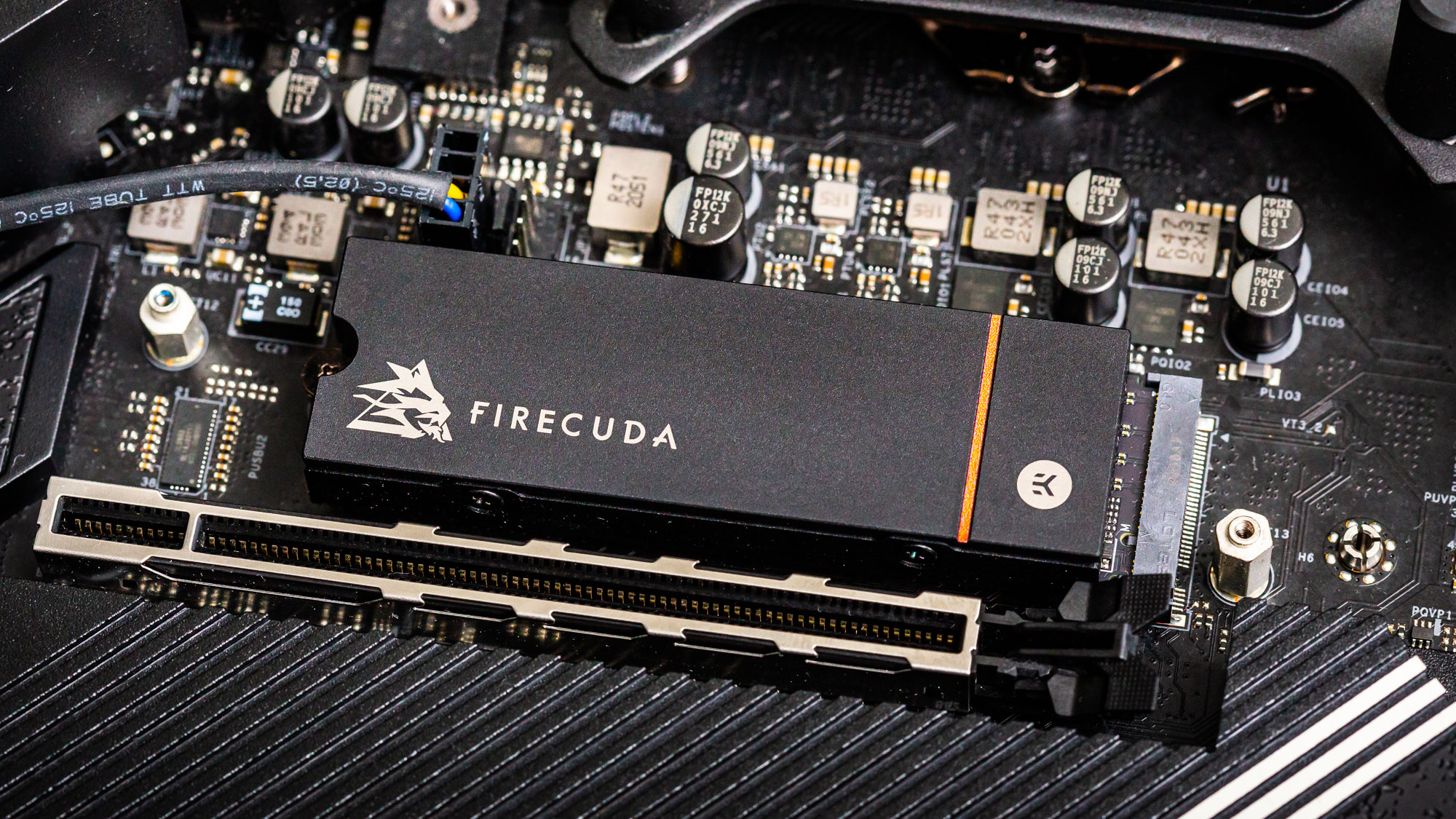
The Samsung 980 Pro and WD_Black SN850 are our Best picks, but that doesn't mean they are the fastest SSDs on the market place. We know Optane's DC P5800X is unearthly fast, but has limited capacity and doesn't come in the same efficient G.ii form factor. The FireCuda 530, on the other hand, is available in capacities of up to 4TB, comes in that small 1000.2 form factor, and delivers incredible sustained write speeds for a flash-based SSD.
If you don't have that deep of pockets for Optane, or maybe just want to out-benchmark your friends, the FireCuda 530 might be up your aisle. Sporting Phison's beastly, penta-core PS5018-E18 NVMe SSD controller and Micron's fast 176-Layer TLC flash, the FireCuda 530 outperforms both the Samsung and WD across the board and information technology comes backed past better warranty and back up service. Nonetheless, its high-functioning, endurance, and data rescue support add quite a bit to pricing, making it a very premium buy targeted for the professional crowd rather than the average gamer.
Read: Seagate FireCuda 530 Review
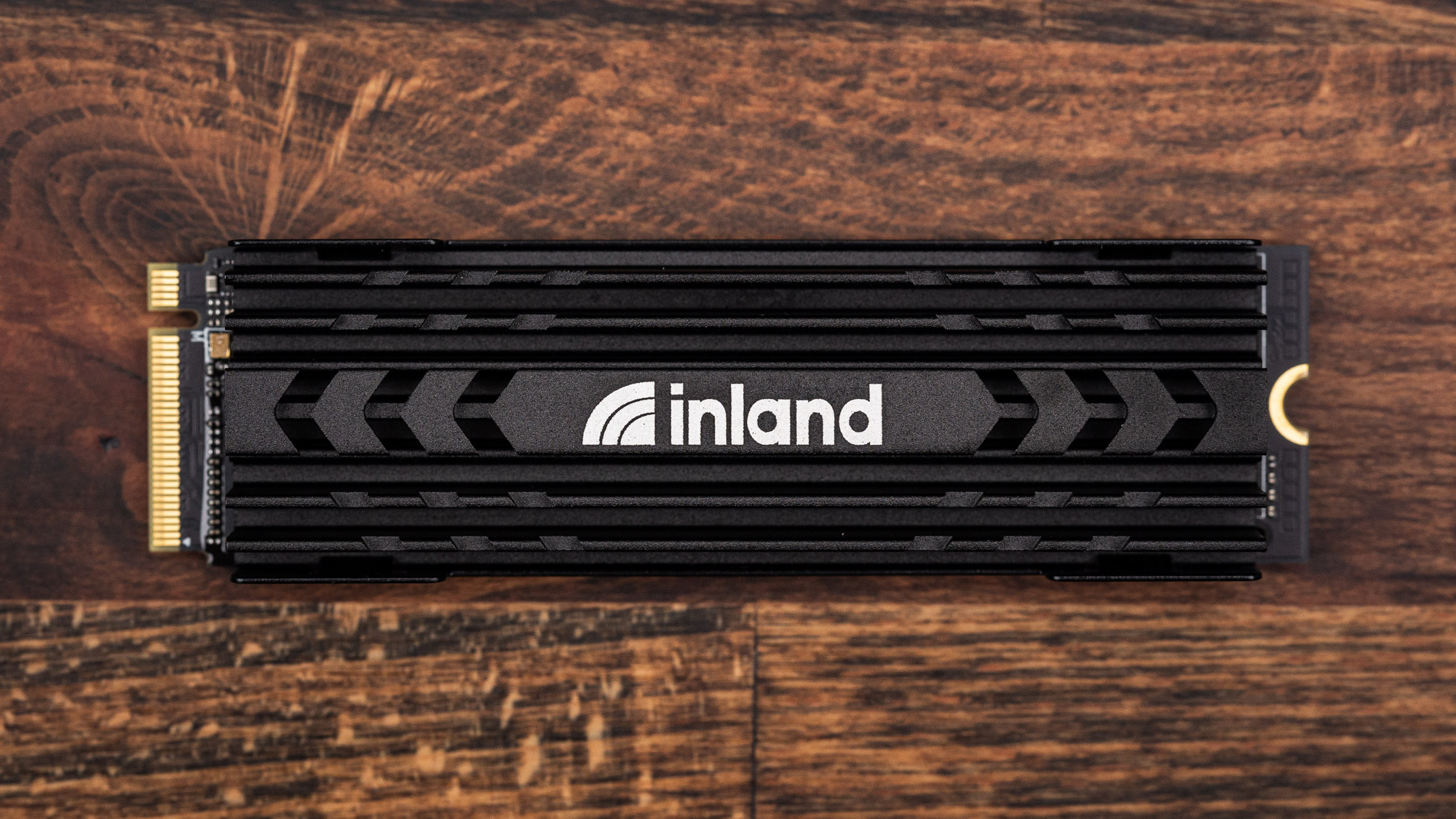
Nosotros have tested both the original version of this drive, which had a heatsink and 96-layer flash, also as the updated Gaming version which has a heatsink and 176-layer wink. Inland as well has updated this model with that wink and now offers a 4TB capacity choice, sans heatsink for all capacities. Nosotros exercise recommend a heatsink for heavier workloads, which can exist added yourself if you don't fancy the Gaming model of Inland's line or need a 4TB option.
The combination of the Phison E18 controller and 176-layer TLC flash from Micron is a match made in heaven: unrivaled peak operation and, with the right cache pattern equally on the Gaming model, strong sustained performance. That is ideal for workstation tasks, and Inland's drives are cheaper than competitor offerings while maintaining a decent warranty. This is a barebones drive simply will get the chore done.
Read: Inland Functioning Plus Review
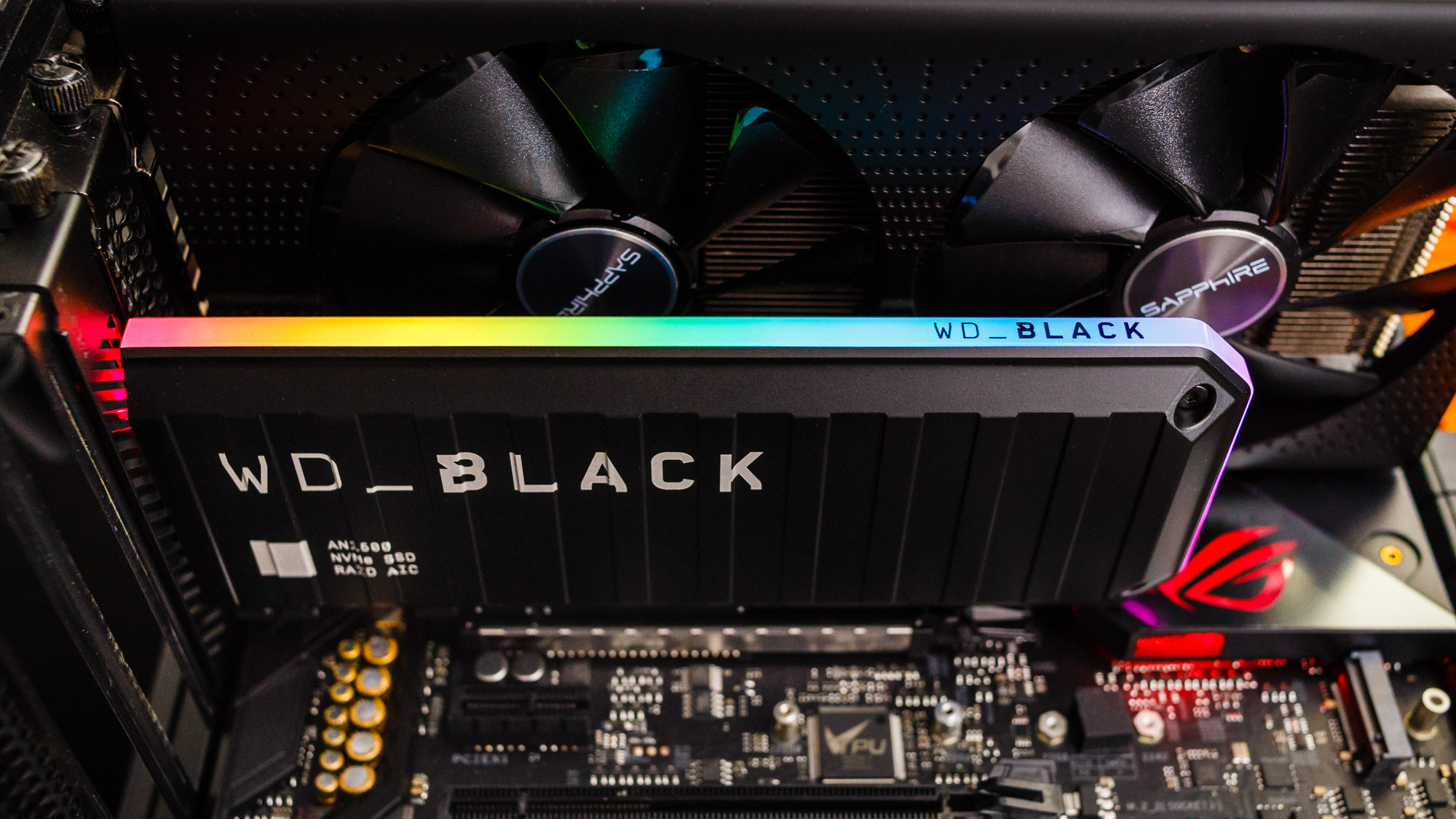
WD's Black AN1500 is a unique NVMe SSD that combines two of the company's SN730 NVMe SSDs and pairs them into a RAID 0 with an enterprise-grade RAID controller. The drive delivers the speed of the PCIe Gen4 interface to systems that just support PCIe Gen3.
The bulldoze delivers upward to 6.4/4.i GBps in sequential read/write functioning, providing PCIe Gen4-like functioning over its PCIe 3.0 X8 interface - simply for systems that don't support PCIe Gen4. Still, while the drive offers upwards incredible performance, it consumes a lot of power and is rather pricey. Fortunately, endurance ratings don't restrict its warranty coverage, and there is, of form, that well-implemented RGB lighting.
Read: WD Black AN1500 Review
Finding Discounts on the Best SSDs
Whether you're shopping for 1 of the all-time SSDs or one that didn't quite make our listing, you may find savings by checking out the latest Crucial promo codes, Newegg promo codes, Amazon promo codes, Corsair coupon codes, Samsung promo codes or Micro Eye coupons.
256gb Sata 3.0 M 2 Ssd,
Source: https://www.tomshardware.com/reviews/best-ssds,3891.html
Posted by: trautmanfultal63.blogspot.com


0 Response to "256gb Sata 3.0 M 2 Ssd"
Post a Comment